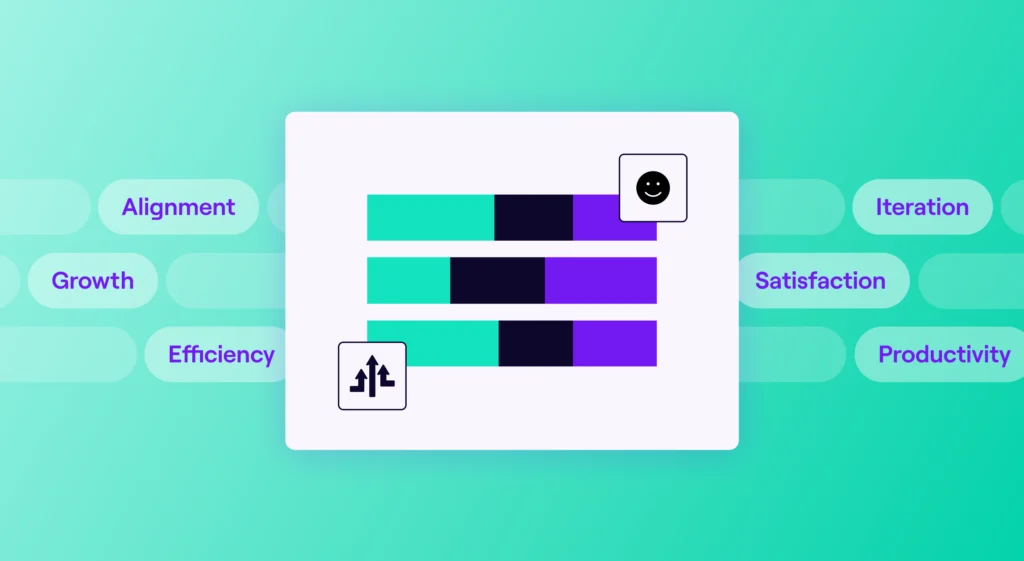We all agree that 1:1s are some of the most important meetings that we have as engineering managers. It’s the time we have with our direct reports to focus on building a relationship, discuss plans for growth, and check in on the team and organizational issues. We want our engineers to feel that 1-on-1s are a productive and safe place to discuss any topic that needs to be addressed. Because Jellyfish believes in the importance of 1-on-1s to a healthy work culture, we’ve explored ways to help supercharge them by using data-driven insights to help us focus on what matters.
The Jellyfish Engineering Approach to 1 on 1s
At Jellyfish, the weekly one-on-one is practice engineering managers are invested in to make sure we stay connected to and are supporting the engineers on our teams. We believe that the agenda is primarily in the hands of the engineer. We want the meeting to be focused on what’s on their mind that week and we want to understand the near and long-term topics of concern for them.
This doesn’t mean that managers have no responsibility in preparing for the meeting. Coming to a meeting you need contextual awareness to engage meaningfully in the conversation. Context is what allows you to engage with the things people talk about and notice the things they don’t talk about. As a manager, you can take the initiative to start the conversation and create a safe space where your report can feel comfortable talking about a difficult topic. Of course, building a safe space for engineers is not an exact science, but after some discussion amongst our team members, there seem to be some common techniques we find from managers that build context well.
Building the Context for 1 on 1s
How does a manager build context? Many of our managers build this through a commitment to taking notes during each one-on-one and reviewing them periodically. It’s a simple step, but with a disciplined approach to this regular habit, your team members will see firsthand your commitment to them and their needs.
Of course, building context doesn’t stop there. Through informal conversations, participating in meetings, and hearing about things through the grapevine, managers fill in the gaps of information that might not come out of 1:1s. Of course, information from these sources can be subjective and many managers will want to augment it with information gathered from Jira or Git to round out the picture of 1.) what is being worked on, and 2.) how the work is being done on their engineering teams.
Building and keeping context is a significant effort and one that scales with the number of teams in your organization. If you’re a team lead or engineering manager it’s your job to be aware of the issues on your team so the things mentioned above are a part of your day-to-day. If you’re a manager of managers with several teams in your organization, you’re depending on your directs for context and using skip-levels to confirm what your managers are telling you.
Engineering Management Platforms (EMP) like Jellyfish can be a game-changer when it comes to getting you context about your teams. Jellyfish does the work of synthesizing the data exhaust from the systems used by your teams to get work done and provides critical insight into “the what” and “how” of the work being done. Reviewing Jellyfish as part of your standard one-on-one preparation helps you to know what’s going on and be prepared for where the conversation will go.
Putting it into practice
Let’s run through a few scenarios common to one-on-one conversations and see how they can be made better with the context you can get from an EMP.
Productivity & Operational Bottlenecks
An engineer might tell you that they’re feeling less productive lately and things are taking longer to get done. They might point to PR reviews taking a long time as a culprit. If you have a dashboard that lets you see the PR cycle time trends at an organization-wide, team, and individual level, you have a better chance of figuring out what the issue might be.
For example, maybe the team is overcommitting to and struggling to prioritize PRs. In this case, you can identify that it’s a group thing and get the team to improve on their sprint planning. But maybe the team is managing their work fine and this is an individual thing. For example, maybe there’s something about how the individual is working. Maybe their PRs are too large and as a result, other engineers are disincentivized from taking them up. Here’s your opportunity to coach the engineer in working more incrementally and putting up smaller PRs. (For more on this see our analysis of Large Pull Requests.) Either way, having some context on the problem helps you and your team members spot places to engage the issue and start making things better.
Painting the Full Picture
If you have an engineer who’s particularly hung up on their PR stats, you might hear during the one-on-one something like “I was so unproductive this week. I got one PR merged at that’s it!”
If you’ve seen the sum total of their work that week, here’s your opportunity to highlight their contributions to the team in the form of the PR reviews and documentation they produced that week. Not everyone’s full contributions are going to be reflected in systems like EMPs, so it’s really important to ensure that you understand the bigger picture, and the rest of the context that you get from the other sources mentioned previously.
Skip Level 1 on 1s
Another example might be the skip level one-on-one where you’re not hearing about a project you know is a priority. Having a dashboard like Jellyfish helps you to see that, despite several tasks sitting “in progress” on the Jira kanban board, a certain project has been stalled for a week. Now it’s your turn to ask “How’s that other project going? Who’s working on it? What challenges are you facing and how can I help with that?”
Most importantly, when you see something going right, EMPs can help ensure you celebrate it. You can take the opportunity to ask more questions and what’s been learned to the rest of the organization. For example, if the team is uniformly reducing their epic cycle time, here’s your opportunity to say something like, “Hey I see delivery is getting faster, that’s really great! What’s the team’s secret? Have you changed something recently?” Take the time to learn and encourage sharing good ideas across the organization. If you ask the right questions and examine the data, EMPs can help find opportunities to spread good cultural habits.
Reflect on Your 1 on 1 Approach
The tricky part about discussing 1:1 best practices is that not every 1:1 is exactly the same. But as the practice of engineering management evolves, we hope that managers regularly reflect on their approach to 1:1s. And as engineering leaders gain access to new capabilities through tools, resources, and data, we should also seek to understand how these things can bring positive change to our workplaces. Jellyfish is striving to enable managers everywhere with data, and we’ll continue to explore use cases where data can enable more productive and safe workplaces.






